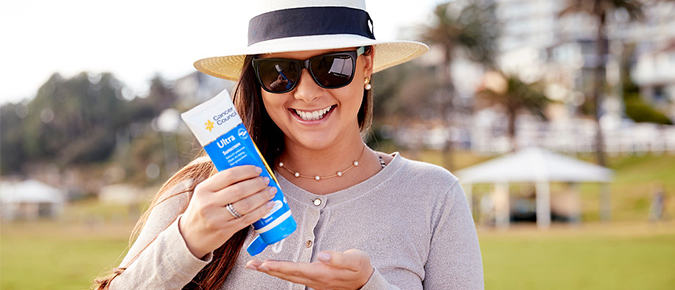
From Gwyneth Paltrow’s post of her dangerously sparse application to Mark Zuckerberg’s full face of zinc, there’s a lot of conversation about sunscreen; how much to wear, how often to apply, what SPF is best.
healthy-lunch-box-win-1-of-5-visa-gift-cards-terms-and-conditions/With summer fast approaching, and daily UV radiation levels already reaching dangerously high levels across Australia, Dermatologist Dr Philip Tong and Cancer Council’s Skin Cancer Prevention Manager, Liz King debunk five of the most widely talked about sunscreen myths.
Dr Tong explains that there are two types of sunscreen ingredients that work in two different ways:
- Sunscreens with absorbing ingredients, which work to absorb nearly all of the UV radiation to protect your skin
- Sunscreens with scattering ingredients, which reflect or scatter most of the UV radiation away from your skin.
Some sunscreens use ingredients which both absorb and scatter UV radiation.
Liz King says, “I often get asked what the best sunscreen is to use and knowing all sunscreens in Australia meet our high regulatory standards, my advice is always to use the sunscreen you like, and to do your best to make it a regular habit.”
“We know there are lots of common misconceptions when it comes to sunscreen, so we wanted to debunk five of the most common sunscreen myths that we hear and see.”
1. Sunscreen alone is enough to protect me
“Sunscreen is not a suit of armour. is an important sun protection measure but should always be used with other sun protection measures: using shade and wearing protective clothing, hats and sunglasses. Whether you use an SPF30 or SPF50+ comes down to personal choice but we always recommend SPF30 or above. An Australian study found that 80% of people don’t apply enough sunscreen when they use it, so for sunscreen to work you need to ensure you apply enough to provide good coverage on all exposed skin and reapply regularly,” Ms King says.
2. My makeup has SPF, so I’m covered
Cosmetics which contain sunscreen are not considered to be a therapeutic product and are therefore not regulated in Australia. They vary in how much SPF protection they provide but it can often be very little, and therefore should not be relied on to protect your skin from the sun. Some people mistakenly believe an SPF20 moisturiser and an SPF10 foundation used together form a protection of SPF30. This is not true. You will only be protected to the level of the highest SPF product – in this case, SPF20 which is not high enough.
If you plan to wear sunscreen and moisturisers or cosmetics, it’s best to apply your sunscreen first – on dry, clean skin. This will allow the sunscreen to disperse effectively. And just like sunscreen, the SPF in cosmetics reduces with time, so remember to reapply sunscreen when you are outdoors.
3. Natural sunscreens are better for me
Recipes for homemade sunscreens are easily found and promoted online, often by individuals without any specific health expertise. These recipes frequently contain coconut or vegetable oils, essential oils, shea butter, beeswax and zinc and may market themselves as organic or natural.
Cancer Council does not recommend making or using homemade sunscreen. Instead, leave sunscreen manufacture to the experts so you know that what you’re using is safe and effective.
4. It’s cold or cloudy today, so I don’t need it
You can get UV radiation damage from the sun on windy, cloudy and cool days. Sun damage is caused by UV radiation, not temperature. A cool or overcast day in summer can have similar UV levels to a warm, sunny day. If it’s windy and you get a red face, it’s likely to be sunburn. There’s no such thing as ‘windburn’.
Sun damage is also possible on cloudy days, as UV radiation can penetrate some clouds, and may even be more intense due to reflection off the clouds.
Ms King says, “Only a quarter of people in NSW use sun protection year-round, even though the UV radiation in NSW is high enough to damage unprotected skin for at least 10 months of the year.”
5. A bit of vitamin D is good for me and my skin
Dr Tong says, “When UV levels are three or above, most people need just a few minutes of sun exposure – such as walking from the office to get lunch, or hanging the washing on the line – to get enough vitamin D. When you are outdoors for more than a few minutes, a combination of sun protection measures is recommended to reduce the risk of skin cancer. In fact, studies have shown daily sunscreen use, coupled with other sun protection measures when outdoors does not compromise the synthesis of vitamin D in healthy people.”
Tips on finding a safe and effective sunscreen:
- Broad spectrum means that the sunscreen provides protection against both UVA and UVB rays.
- Pick a sunscreen that is SPF30 or higher.
- Make sure your sunscreen is applied correctly. For a full body application, apply at least seven teaspoons 20 minutes before heading outdoors and reapply every two hours after your last application.
- Choose a sunscreen you find easy and pleasant to apply, that way you use it regularly.








